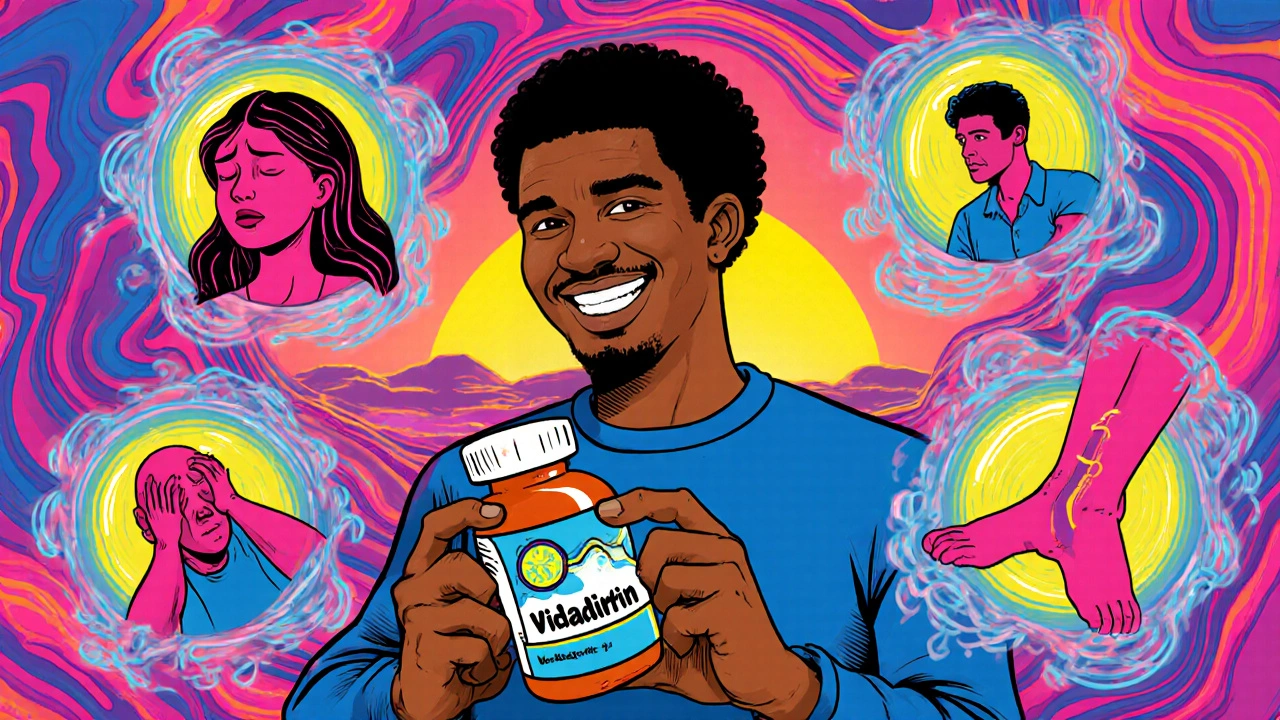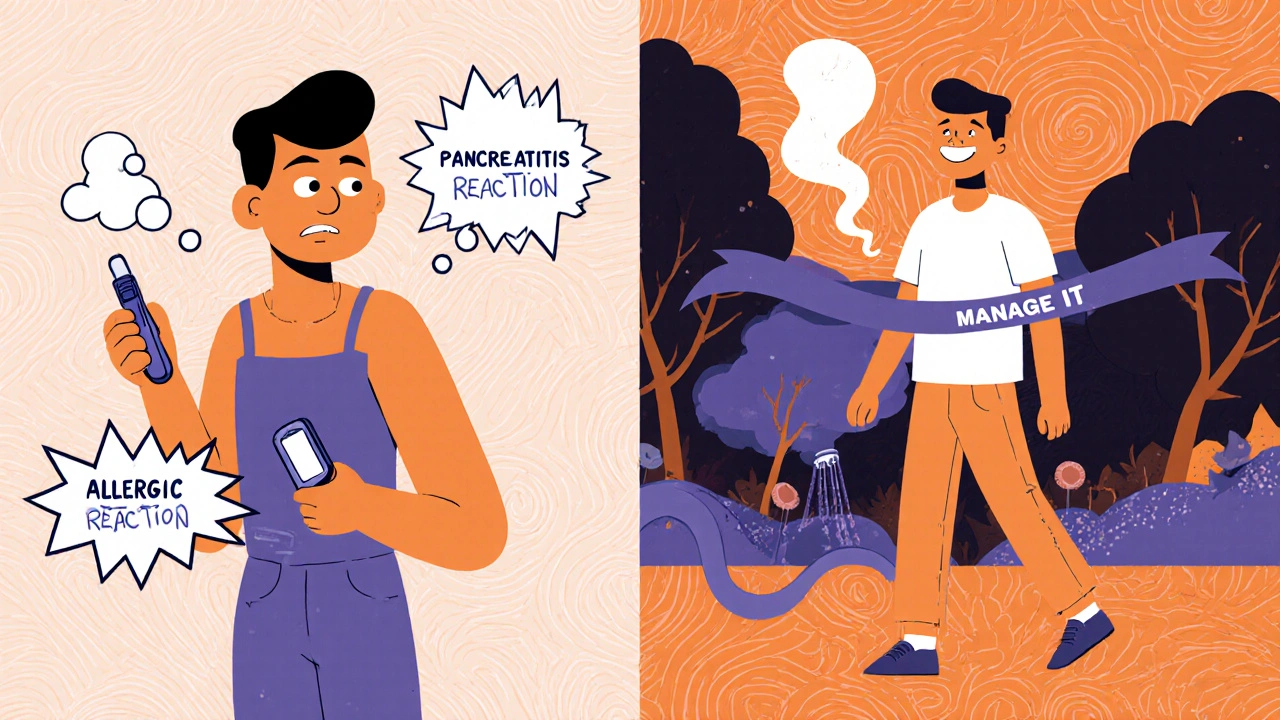Common Side Effects of Vidagliptin: What to Expect and How to Manage Them

If you’ve been prescribed vidagliptin for type 2 diabetes, you’re not alone. Millions of people take this medication every day to help control blood sugar. But like any drug, it doesn’t come without possible side effects. The good news? Most are mild, temporary, and manageable. The key is knowing what’s normal and when to call your doctor.
What vidagliptin actually does
Vidagliptin is a DPP-4 inhibitor. That’s a mouthful, but here’s what it means in plain terms: your body naturally breaks down a hormone called GLP-1 after you eat. GLP-1 helps your pancreas release insulin when blood sugar rises. Vidagliptin blocks the enzyme that destroys GLP-1, so your body keeps more of it active. That means better insulin control after meals and less sugar floating in your blood.
It’s not a fast-acting drug like insulin. You won’t feel it kick in right away. It works quietly over days and weeks. That’s why it’s often paired with metformin or other diabetes meds. It’s meant to be part of a long-term plan, not a quick fix.
Most common side effects
Based on clinical trials and real-world use, here are the side effects you’re most likely to experience:
- Headaches - Occur in about 1 in 10 people. Usually mild and go away after a few weeks.
- Upper respiratory infections - Stuffy nose, sore throat, cough. Not caused by vidagliptin directly, but your immune system might react slightly differently while on it.
- Joint pain - Affects around 3-5% of users. Often described as a dull ache, mostly in knees or hands. Not arthritis, but can feel like it.
- Swelling in hands or feet - Called peripheral edema. Happens more often if you’re also taking a thiazolidinedione like pioglitazone.
- Low blood sugar (hypoglycemia) - Only if you’re taking vidagliptin with insulin or sulfonylureas. Alone, it rarely causes this.
These aren’t scary. They’re the kind of things you might brush off as stress, aging, or a cold. But if they stick around or get worse, don’t ignore them.
Less common but serious side effects
These happen rarely - less than 1 in 100 people - but they’re important to know because they need quick action.
- Pancreatitis - Severe, constant pain in your upper belly that radiates to your back. Nausea, vomiting, fever. If you feel this, stop taking vidagliptin and get medical help immediately. There have been rare reports linking DPP-4 inhibitors to this condition.
- Allergic reactions - Hives, swelling of the face or throat, trouble breathing. This is an emergency. Call 999 or go to A&E.
- Severe skin reactions - Blistering, peeling, or rash that spreads. Cases like Stevens-Johnson syndrome are extremely rare but life-threatening.
- Heart failure - Especially if you already have heart disease. Signs: sudden weight gain, swollen ankles, trouble breathing when lying flat. Talk to your doctor if you notice these.
These aren’t things you’ll likely experience. But if you’ve had pancreatitis before, or a history of severe skin reactions, tell your doctor before starting vidagliptin.
How to manage mild side effects
Most side effects fade on their own. But you don’t have to just wait it out.
For headaches: Stay hydrated. Dehydration makes them worse. Try paracetamol if needed. Avoid caffeine crashes - they can trigger headaches too.
For joint pain: Gentle movement helps. Walk for 20 minutes a day. Stretching or yoga can ease stiffness. If it’s worse in the morning, a warm shower before getting up can help.
For swelling: Elevate your legs when sitting. Avoid standing for long periods. Cut back on salt. Your doctor might adjust your other meds if this persists.
For cold-like symptoms: Wash your hands often. Use a saline nasal spray. Rest. Don’t assume it’s just a virus - if it lasts more than 10 days, get checked.
Keep a simple journal. Note when side effects start, how bad they are, and what you did that day. You’ll spot patterns. Maybe your joint pain flares after a long walk. Or your headache hits after skipping breakfast. That info is gold for your doctor.

When to call your doctor
You don’t need to panic over every little thing. But here’s when to pick up the phone:
- Any sign of an allergic reaction - hives, swelling, breathing trouble
- Severe belly pain with vomiting - could be pancreatitis
- Unexplained skin rash or blistering
- Sudden weight gain or swelling in legs - heart failure risk
- Low blood sugar that keeps happening - especially if you’re not on insulin
- Side effects that last more than 3 weeks and don’t improve
If you’re unsure, call your GP or NHS 111. Better safe than sorry.
What you shouldn’t do
Don’t stop taking vidagliptin just because you feel a bit off. Stopping suddenly can cause your blood sugar to spike, which is dangerous over time.
Don’t mix it with herbal supplements without checking. Some, like bitter melon or fenugreek, can lower blood sugar too - and with vidagliptin, that could push you into hypoglycemia.
Don’t assume it’s fine just because your friend took it without issues. Everyone reacts differently. Your body, your history, your other meds - they all matter.
What to expect in the first month
Week 1-2: You might feel nothing. Or you might get a headache or mild stuffy nose. That’s normal.
Week 3-4: Your blood sugar readings should start to stabilize. If they’re still high, your doctor might adjust your dose or add another medication.
Week 5-6: Most side effects fade. If you’re still having joint pain or swelling, talk to your doctor. It’s not normal to feel this way long-term.
By the end of the first month, you should have a clearer picture. If you’re feeling better and your HbA1c is dropping, you’re on the right track.

Who should avoid vidagliptin
Vidagliptin isn’t for everyone.
- If you’ve had pancreatitis before - avoid it.
- If you’re allergic to any DPP-4 inhibitor (like sitagliptin or linagliptin) - don’t take it.
- If you have severe kidney disease - your doctor may skip it or lower the dose.
- If you’re pregnant or breastfeeding - it hasn’t been studied enough in these cases.
Your doctor should have checked your kidney function before prescribing. If they didn’t, ask. Kidney health affects how your body processes this drug.
How vidagliptin compares to other diabetes drugs
Compared to metformin, vidagliptin is less likely to cause stomach upset. But metformin often helps with weight loss - vidagliptin usually doesn’t.
Compared to sulfonylureas, vidagliptin has a much lower risk of low blood sugar. That’s a big plus.
Compared to GLP-1 injections (like semaglutide), vidagliptin is a pill and cheaper. But it doesn’t help with weight loss as much.
It’s not the strongest drug out there. But for many people, it’s the right balance: effective, well-tolerated, and easy to take.
Final thoughts
Vidagliptin isn’t a miracle drug. But for millions of people, it’s a reliable tool. Most side effects are minor and fade. A few are serious - but rare. The goal isn’t to avoid all side effects. It’s to recognize them early, manage them wisely, and keep your blood sugar stable.
If you’re feeling unsure, talk to your pharmacist. They see hundreds of patients on this drug every week. They know what’s normal and what’s not. Don’t be shy - ask questions. Your health is worth it.
Can vidagliptin cause weight gain?
Vidagliptin is generally weight-neutral. Unlike some other diabetes medications like insulin or sulfonylureas, it doesn’t typically cause weight gain. Some people may gain a small amount due to fluid retention or improved blood sugar control leading to less sugar being lost in urine, but significant weight gain is uncommon.
Is it safe to take vidagliptin long-term?
Yes, vidagliptin is considered safe for long-term use. Clinical studies lasting up to 10 years show no increased risk of cancer, heart disease, or organ damage when used as directed. Regular kidney and liver checks are recommended, especially if you’re over 65 or have other health conditions.
Can I drink alcohol while taking vidagliptin?
Moderate alcohol is usually fine, but it increases the risk of low blood sugar - especially if you’re also on insulin or sulfonylureas. Stick to one drink a day, never drink on an empty stomach, and monitor your blood sugar more closely if you do.
Does vidagliptin affect the liver?
Rarely. In clinical trials, less than 1% of users showed mild, temporary increases in liver enzymes. No cases of serious liver damage were linked directly to vidagliptin. If you have existing liver disease, your doctor may monitor you more closely.
What happens if I miss a dose?
If you miss a dose, take it as soon as you remember - unless it’s almost time for your next dose. Don’t double up. Missing one dose won’t cause a big spike, but consistently skipping doses will make your blood sugar harder to control. Set a daily phone reminder if needed.
Pradeep Kumar
October 31, 2025 AT 15:45Justin Vaughan
November 1, 2025 AT 01:02Matthew Kwiecinski
November 1, 2025 AT 20:57Jens Petersen
November 3, 2025 AT 13:59andrea navio quiros
November 4, 2025 AT 17:10Brittney Lopez
November 6, 2025 AT 08:23Keerthi Kumar
November 7, 2025 AT 18:46Manuel Gonzalez
November 8, 2025 AT 22:36Andy Ruff
November 9, 2025 AT 11:34